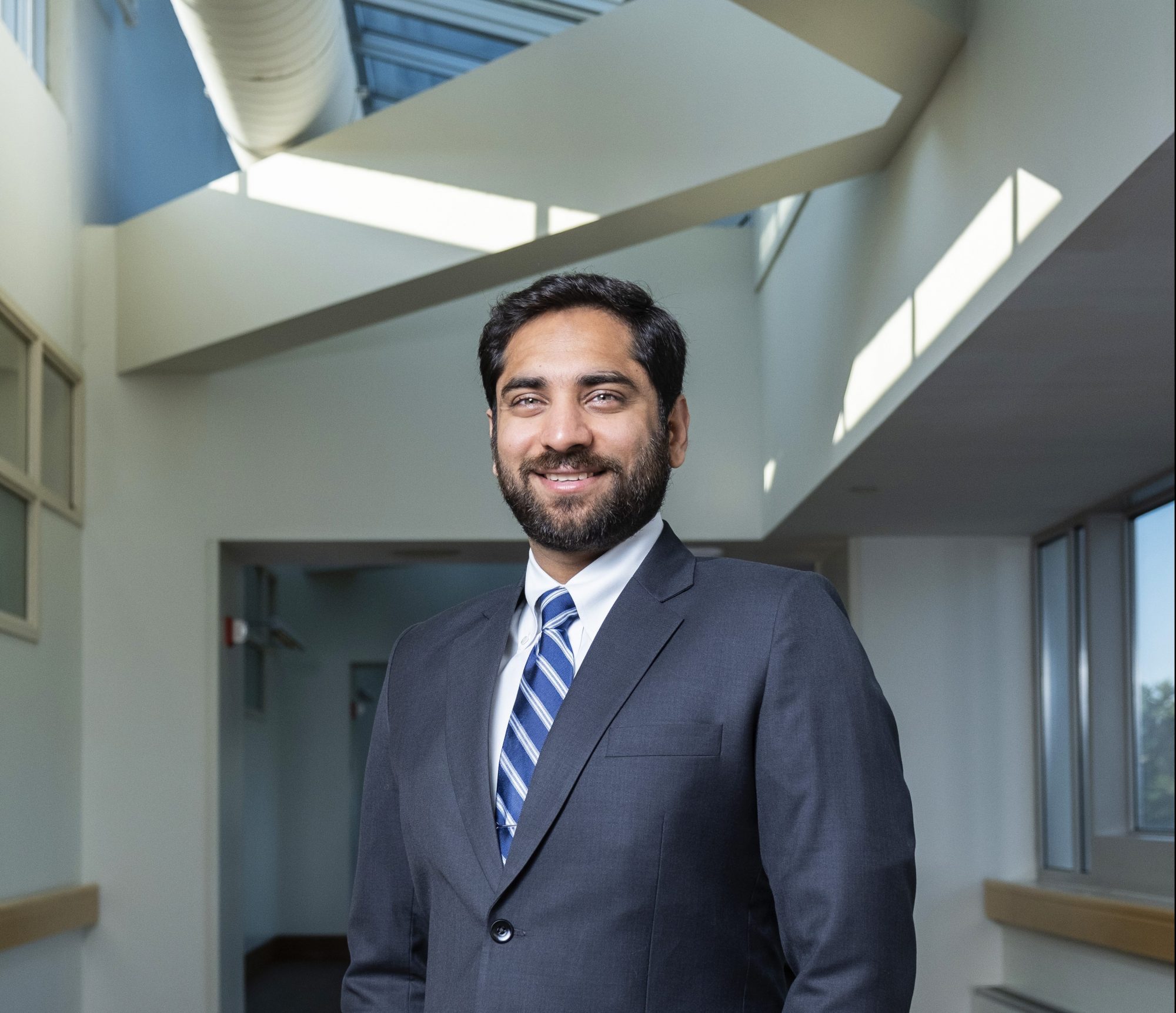Diagnosing interstitial lung disease (ILD) requires a lot of detective work, according to Rahul Mutneja, MD, director of Saint Francis Hospital and Medical Center’s year-old ILD program. This is because ILD, a group of disorders that leads to scarring of the lung tissue and impaired breathing, can stem from a wide range of causes, including autoimmune disease, exposure to environmental toxins, and oversensitivity to airborne particles like dust or mold.
“You have to spend a lot of time with the patient and you have to think of several things when trying to make a diagnosis,” says the pulmonary medicine/critical care specialist. “Where do you live, what do you eat, what’s in your house, where have you worked, how many jobs have you had in your life, what did your parents do? The intellectual part of it is really stimulating.”
Though there are more than 200 disorders that fall under the umbrella term ILD, says Dr. Mutneja, it is a relatively rare disease, and there are only a few centers of excellence dedicated to the illness. “I joined this institution last year with the goal of setting that up for Saint Francis and our sister hospitals,” he says.
Giving back to the program
Dr. Mutneja was born in Punjab, a state in northern India. He received all of his schooling in his native country, ultimately earning a Bachelor of Medicine and a Bachelor of Surgery at Bangalore Medical College and Research Institute. There, senior classmates who were preparing for the U.S. medical exams piqued Dr. Mutneja’s interest in doing his residency training in America.
“I really loved how the education system is here – it is a little more structured than in India, with an emphasis on clinical skills,” Dr. Mutneja recalls. He zeroed in on UConn because its Internal Medicine residency program was one of the biggest in the U.S. “I also liked how the director and staff of the UConn/Saint Francis Internal Medicine and Pulmonary Critical Care programs were very welcoming and approachable – it wasn’t like we were working for them, but like we were part of a big family. They made me feel that way in the first few hours I spent with them during my interview.” He also took an immediate liking to the beauty of Connecticut. He went on to finish his residency and fellowship, and also met and eventually married his wife, who was training in the same program.
Dr. Mutneja stayed at Saint Francis when he finished his training. “I had so many relationships there with the people – the pulmonologists in my practice are the ones who trained me,” he says. Now, Dr. Mutneja, in turn, trains the hospital’s pulmonary medicine and critical care fellows, as well as residents in internal medicine, family medicine and emergency medicine, and medical students from UConn and Quinnipiac. “It seemed like the best way to give back to the program,” he says.
He also enjoys the ongoing collaboration and interaction with his peers. “Dr. [Daniel} Gerardi, section chief of my department, is hosting its 23rd annual pulmonary symposium at Saint Francis this month, and I look forward to connecting with and sharing ideas with our pulmonary colleagues.”
A disease that is managed, not cured
Dr. Mutneja likens the scarring associated with ILD to the scarring that occurs when a person sustains an injury, say, to the hand. “It typically heals with a scar, but that scar may stay with you for life,” he says. “ILD occurs when the lung doesn’t heal properly and leaves a scar on your lung. The scarring in the lungs replaces your normal lung tissue, making your lungs stiff, so that they can’t pull in a lot of air,” he explains. “It’s like a balloon – balloons are typically very compliant, but you really have to work hard to push air into a thick balloon.”
The majority of ILD cases stem from connective tissue diseases like Sjögren’s syndrome, scleroderma and rheumatoid arthritis. The immune system of people with these autoimmune diseases goes awry and attacks healthy connective tissue, like cartilage in the joints or collagen in the skin, causing inflammation and scarring. In some cases, these disorders also cause inflammation of – and damage to – lung tissue.
But ILD can also be caused by exposure to environmental toxins like silica dust or asbestos, or even to more common pollutants in the air, such as mold, dust or chemicals. Patients who have occupational exposure to fibrous materials that can be breathed in and cause damage to the lung – like cotton and sugar cane farmers, and people who work with coal or asbestos – are at risk. “There is a small minority of people who get allergic reactions to mold or dust particles in the air, and their body reacts in an exaggerated way, leading to scarring in the lungs,” says Dr. Mutneja. For people with these reactions, symptoms often go unnoticed – “until they start having a cough that won’t go away, or shortness of breath while exercising, walking or doing household chores.”
Smoking can also lead to ILD, he adds. Tobacco smoke can damage the air sacs, causing them to fill up with inflammatory material, or can cause respiratory bronchiolitis, an inflammation and narrowing of the small airways in the lungs.
Scarring in the lung tissue can’t be eliminated, notes Dr. Mutneja, so the focus of ILD treatment is to find out what caused it and stop it from progressing. “ILD is something that is managed, not cured, in majority of the cases” he says. The appropriate management can also improve patients’ quality of life, he adds.
A tricky diagnosis
The tricky part about ILD, says Dr. Mutneja, is that many of the symptoms – persistent cough, shortness of breath, fatigue – are commonly associated with other conditions. A tenacious cough can be a sign of post-nasal drip or chronic heartburn; shortness of breath can be a symptom of cardiac issues. Still, says Dr. Mutneja, “If you have something new or something that has changed, like a cough that’s not going away or sudden shortness of breath, you should consult your doctor.”
Sometimes, Dr. Mutneja says, primary care physicians pick up ILD during routine check-ups; indeed, he had recently had two such referrals. “I’ve had two patients in the last three weeks whose doctors, when listening to their lungs, heard what is called rales, a crackling sound that you can hear through the stethoscope and that is a subtle sign of scarring in the lungs,” he explains. “Those were ideal situations where the disease was picked up before it progressed to where the patients were having symptoms.”
Typically, however, ILD is picked up after damage has already been done, and patients are experiencing symptoms. Dr. Mutneja says he spends about an hour during the initial visit with suspected ILD patients, taking an extensive history, which includes questions about symptoms and exposures the patient has had at work and at home. (Is there water damage or a humidifier that hasn’t been cleaned?) He conducts antibody tests and other blood tests to check for autoimmune disorders. He sends patients for a high-resolution CT scan of the lung “to get a precise picture of what is happening with the lung tissue.” He usually checks the lung tissue via surgical biopsy as well.
“You put all this together with a team of physicians – the pulmonologist, radiologist, pathologist – and we all discuss how we should approach the patient,” says Dr. Mutneja. “The biggest highlight of our ILD program is that you have a team of specialists trying to solve this problem from different angles. This collaborative approach continues throughout a patient’s treatment at Saint Francis.”
Doctors collaborate regularly and meet monthly to discuss when treatment should be changed or what to do about a patient not responding to treatment, or to decide whether a patient with progressive disease should be referred for transplant.
Management of ILD depends on the cause, though many patients ultimately end up requiring oxygen to help them breathe. “But medications do help stabilize the disease, and pulmonary rehab – which we have at Saint Francis – helps improve quality of life,” says Dr. Mutneja. Pulmonary rehab focuses on breathing exercises and building endurance. Steroids and other immunosuppressive medications can sometimes help reduce inflammation in the lungs as well. Of course, if ILD is due to environmental exposure, the first step is to eliminate any further exposure.
Though people don’t always know that they are being exposed to something that is damaging their lungs, those in occupations that entail exposures to dangerous substances should be sure not to work without protection, Dr. Mutneja says. Quitting smoking is another way to prevent ILD. “But early recognition can go a long way in preventing progression to severe disease and improving quality of life,” he says. “So get attention at the first sign that something is off.”
Treating the critically ill
In addition to running the ILD program, Dr. Mutneja sees patients suffering from other pulmonary diseases, like asthma, chronic obstructive pulmonary disease (COPD), and lung cancer. He also spends at least two weeks each month caring for critical care patients in the intensive care unit (ICU).
“Critical care ultrasonography is one of my other passions,” says Dr. Mutneja, who has special expertise with this technology. “Use of these portable ultrasound machines in critically sick patients can get you quick answers to determine what could be making them sick. Critical care ultrasound also improves the safety profile of procedures performed in the ICU, he says. “If I have to drain fluid from someone’s chest, for example, I can see exactly where I’m going, which reduces the risk of complications.”
Dr. Mutneja says that he finds both his work in the ICU and his work with ILD patients to be extremely fulfilling. “Spending time with ILD patients and doing the detective work involved in caring for them and helping to improve their quality of life gives me personal and professional satisfaction,” he says. “And in the ICU, seeing patients who were very, very sick get better right in front of you is very rewarding. There’s not a single day that I go home that I don’t feel like I did some good today.”
Lori Miller Kase is a freelance writer living in Simsbury.
Photography by Connecticut Headshots. Connecticut Headshots, located in Avon, offers corporate portrait photography services to professionals in a variety of industries. Visit www.connecticutheadshots.com.








More Stories
Jamie Shawver, D.O.: The Modern-Day Family Doctor
Leading in Urologic Oncology: Ryan Dorin, M.D., Works on Expanding Patient Care
UConn Health Stands at the Forefront of Comprehensive Sickle Cell Treatment in the U.S.